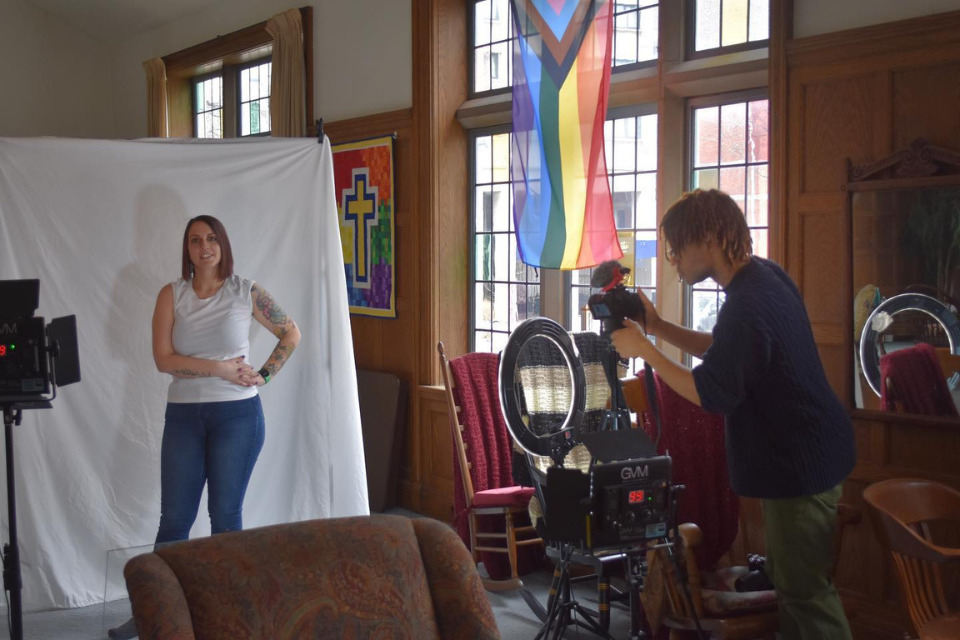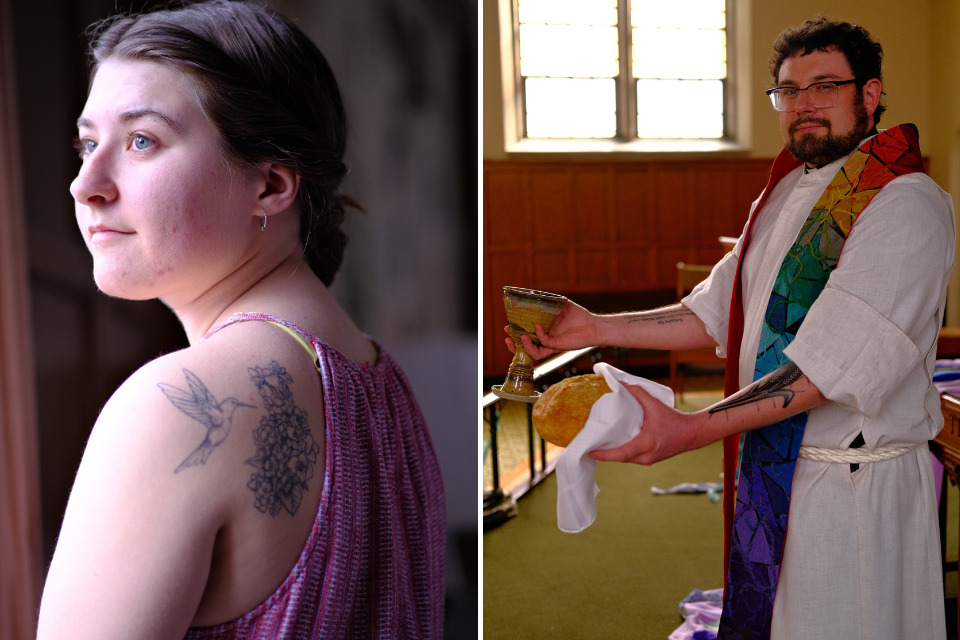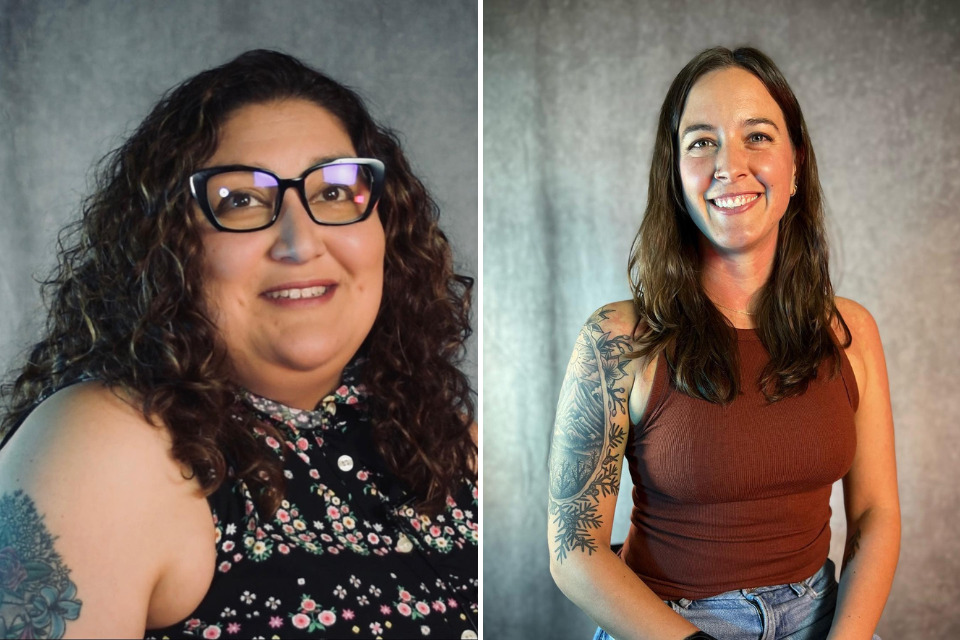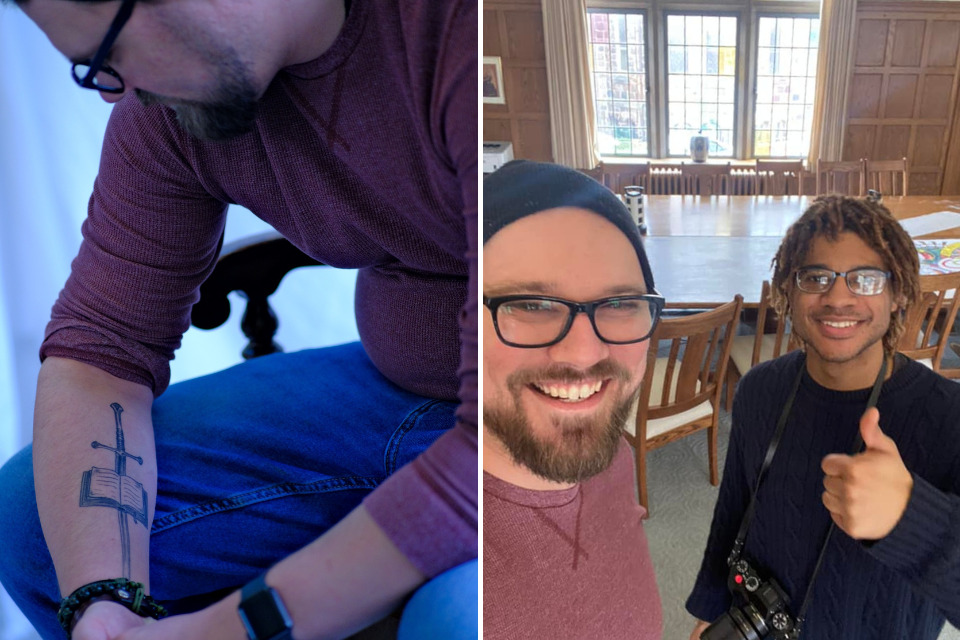People of faith tell the stories behind their spiritual tattoos in a new touring photographic art exhibit sponsored by the Wesley Foundation at the University of Michigan.
JAMES DEATON
Content Editor
The Wesley Foundation at the University of Michigan, the United Methodist campus ministry, is preparing to unveil Sacred Ink, a new traveling art exhibit featuring photographs and stories of people of faith and their tattoos. The interactive gallery hopes to engage the community, including churches in the Michigan Conference, in conversation about this artistic expression and how it is more than skin-deep. For many wearers, tattoos are ever-present reminders of deeply personal, sacred stories.
Sacred Ink’s opening gala will be held on Friday, October 27, 2023, from 7 to 9 pm, in Wesley Lounge at the Wesley Foundation, 602 E. Huron St., in Ann Arbor, MI. Sixteen large photographs will be shown, along with an art talk featuring the two photographers and some of the models. The exhibit will run for a week before it is prepared to travel around the state.
The Wesley Foundation seeks churches or groups to host Sacred Ink as it tours the area starting in November. Groups interested in bringing the exhibit to their community should contact Rev. Tim Kobler, chaplain and director of the Wesley Foundation, at timkobler@umichwesley.org, or complete this online form. Hosting the exhibit requires space for 16 large-format photos and a video monitor. The Wesley Foundation also asks for a freewill offering to help cover the travel expenses of transporting the exhibit.

As Rev. Tim Kobler has spent time on the campus of the University of Michigan, he believes that young adults have spiritual connections, even if they don’t align themselves with a specific faith tradition or Christian denomination. And he wants people in the pews to get to know some of these young adults by seeing (and hearing) their faith stories through their tattoos.
Kobler says the idea for Sacred Ink was inspired by a clergy colleague who started a similar art project with her church to engage their community. He notes that Sacred Ink builds on that idea and adds depth through a multimedia experience of images, words, and video. With mobile devices, viewers can scan QR codes next to the art to access brief video interviews with the models in which they tell the story behind their tattoos and why they chose them.
The Wesley Foundation established a relationship with the renowned Penny W. Stamps School of Art & Design at the University of Michigan to move the project forward late in 2022. Gabrielle Mack and Myles McGhee (read bios here), two art school graduates, were selected to photograph the 16 persons of faith who had responded to the invitation to join the project.

Of the 16 photographic models, most were Christian, including 10 United Methodists, but there were two Jewish models and some seekers not identified with a specific religion. Eight of the models were clergy, including several United Methodist elders.
Working with Kobler and learning about the mission of the Wesley Foundation was a great experience for Myles McGhee, one of the Sacred Ink photographers. McGhee appreciates how Kobler invited him into the process early on, giving him the freedom to utilize his gifts as he approached the creative challenge. In many ways, it felt like a genuine partnership.
McGhee explains that it was important for him to learn about and observe his subjects, notice their habits, rhythms, and personalities, and then learn how to take a picture of a tattoo on a living human being in a way that doesn’t look like documentation or just a portrait.

Each session was unique as the photographer interviewed each model on video to learn about their tattoos and the stories behind them. That opened up the creative process for McGhee as he got to know each model and bring them into focus. “They were all incredible to me,” said McGhee. “I was amazed how they volunteered to come and tell their story. They were excited about it, and you could see how cathartic it was for them to talk about where they’ve been, what their tattoo means to them, and why they chose it. It’s a really cool project.”
Through art and storytelling, Sacred Ink illuminates the faith journeys of 16 individuals as depicted in their tattoo art. Kobler explains, “There is a deeply personal story behind every tattoo, and they can signify important people or events in their lives and often have deep spiritual roots. Each time the tattoo’s story is told, it further deepens the spiritual significance and connection with the wearer. The telling of their story becomes like a sacred litany.”
The wearing of tattoos is an expression of faith and spirituality going back generations for some traditions, even though we see fewer younger adults involved in organized religion today. A recent Pew Research survey concluded that 47% of tattooed adults got one to make a statement about their beliefs. In many ways, the wearing of “sacred stories” on their sleeves is an open door for conversation for the Sacred Ink models as they give witness to their identity as beloved children of God. It’s a form of evangelism or spreading good news.

“Almost everyone who has a tattoo has had the experience of curious people asking about their ink and the meaning behind it,” says Kobler. “The telling of the sacred meaning behind the tattoo art invites the hearer to engage with their own sacred story and to think theologically.”
Kobler invites Michigan United Methodists to experience Sacred Ink for themselves by attending the free opening gala in Ann Arbor on Friday, October 27, or by contacting him to host the touring exhibit in the coming months. Those interested in learning more can watch the promotional video (click here) or visit their website and Facebook and Instagram feeds.
“Bringing Sacred Ink to your community can be a great way to engage your community and perhaps make contact with folks who might not normally attend church events,” concludes Kobler. “I also think the exhibit will help bridge the generational gap, helping older people realize that young people do think theologically and engage in spiritual practices.”
Tattoo-wearing may look and feel different from traditional faith expressions or practices, but as Sacred Ink reveals, it is just as spiritually rich, honest, and fulfilling.
Last Updated on October 31, 2023


